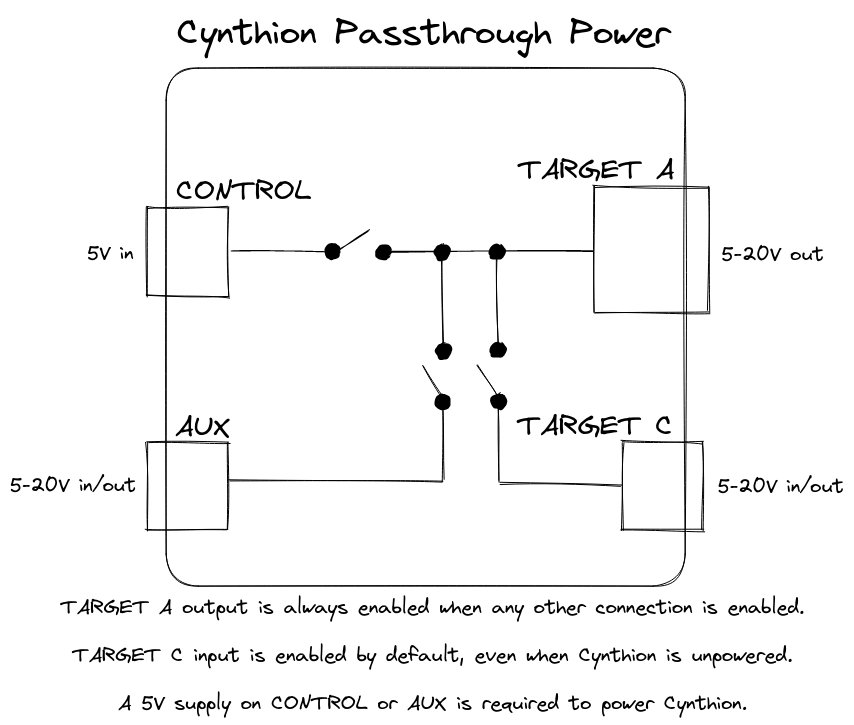Great Scott Gadgets
Cynthion Hardware Design Update
Note: This is a crosspost of a Cynthion update on Crowd Supply: https://www.crowdsupply.com/great-scott-gadgets/cynthion/updates/cynthion-hardware-design-update.
We’ve completed the Cynthion r0.6 design! As mentioned in previous updates we needed to modify the design to accommodate new components due to supply chain issues. In this revision additional changes were made to resolve some problems beta testers identified with both power input and power output.
Issues Found During Beta Testing
Power input issues: When you plug Cynthion into a host computer, it is expected that Cynthion powers up and that the host computer will recognize that a device has been attached. Our beta testers found a couple of situations in which those things would not happen reliably. These scenarios were caused by a confirmed issue with excessive reverse leakage through a diode and a suspected issue with loading of the CC pins on the USB Type-C connectors.
Power output issues: Cynthion can pass power from a host computer (either the control host or a target host) through to a target device. Although this worked reliably, there was a problem that caused excessive power consumption and another problem that could theoretically damage a component on Cynthion.
Rethinking Power Distribution
As we investigated various power input and output issues over the past year or so, we sketched solutions planned for r0.6. When it came time to design r0.6, however, we realized that those solutions were insufficient.
Additionally, we realized that older versions of Cynthion were vulnerable to damage from high voltage input on any of the USB Type-C connectors. Originally designed with Micro-B connectors, Cynthion was later updated with Type-C connectors, introducing a much greater probability of accidental high voltage.
Micro-B connectors are intended to carry 5 V power, but Type-C connectors were designed to support up to 20 V, later extended to 48 V. USB hosts and power supplies are supposed to supply only 5 V unless the device asks for a higher voltage, but a noncompliant implementation could supply up to 20 V without negotiation.
Partly out of concern for overvoltage, we had implemented very limited Power Delivery (PD) capabilities in previous hardware revisions, minimizing the probability of input voltages higher than 5 V. However, our PD implementation may have contributed to other problems, and it did nothing to protect Cynthion from overvoltage from a noncompliant power supply.
We decided to completely rethink both power input and power output. After multiple rounds of design, simulation, and test, we’re happy to report that Cynthion’s capabilities are better than ever before!

image caption: a prototype board, essentially a Cynthion with everything removed except power distribution and monitoring
What’s New in r0.6
The USB ports are now renamed:
-
CONTROL is the primary port for control of Cynthion. Both the FPGA and the on-board debugger are now controlled over this port, so a second connection to the control host is no longer required.
-
TARGET C connects to a target host.
-
TARGET A connects to a target device and is directly connected to TARGET C, passing through data signals and allowing USB analysis.
-
AUX is an auxiliary port that can be used for various purposes, including MitM or as a secondary control port for development.
Cynthion now supports power passthrough up to 20 V, the highest voltage allowed in PD’s Standard Power Range (SPR). Power can now pass through to the AUX port in addition to the TARGET ports. PD’s Extended Power Range (EPR) is not supported.

A 5 V power supply is still required on either CONTROL or AUX to power Cynthion itself, but the hardware now allows the user to select which port to use if 5 V supplies are available on both ports. Overvoltage protection automatically shuts off either input if it exceeds 5.5 V.
Power input and power passthrough are now two separate functions, no longer entangled with one another. All power output is strictly passthrough, not an output of an internal supply rail. Overvoltage shutoff of an input does not affect passthrough. There is no longer a diode drop reducing passthrough voltage.
All four ports now feature voltage and current monitoring, allowing Cynthion to measure passthrough power as well as its own power usage. The power monitoring capability can be used to implement flexible overvoltage, overcurrent, or reverse current protection for external hosts or devices, though with a slower response time than Cynthion’s internal overvoltage protection.
TARGET C and AUX now each have a Type-C controller implementing bidirectional PD communication on the CC pins. This significant improvement in PD capabilities was made possible in part by the power distribution redesign. The Type-C controller additionally allows VCONN output that can be used, for example, to power electronically marked cables.
A new USER button provides input to the FPGA, allowing direct interaction with gateware running on Cynthion.
The Pmod connectors are moved to the same edge of the board making Cynthion compatible with dual Pmods. A new mezzanine connector provides additional expansion capability.
Cynthion is now physically larger. The PCB dimensions increased from 48x48 mm to 56x56 mm. This will accommodate future revisions with physically larger FPGA packages or other components. During the r0.6 design phase we unexpectedly received some delayed components which we will use in the first production to reduce risk, but we need room to allow future use of alternative parts purchased during the shortage.
New mounting holes in the corners allow the PCB to be firmly fastened to an enclosure. 3D render of Cynthion r0.6

Next Steps
Prototypes of Cynthion r0.6 have been assembled, and we are testing them now. We anticipate one more hardware revision before production, but we expect it to include only minor updates. Initial testing of r0.6 is going very well, probably because we already prototyped smaller sections of it separately.
Taylor and Martin are now working hard on designing a test jig and software for factory testing. Much of this work couldn’t be done until the r0.6 redesign was complete, but we are now making rapid progress.
Timon has already completed an update of the enclosure design for new form factor, and we will have samples made very soon. Once we have samples that pass inspection we’ll be able to design packaging.
All of these steps will take time, and they were delayed by the r0.6 redesign effort. As a result, we expect to begin shipping LUNA in August 2023 instead of June 2023, but we think the many improvements in the latest revision will be worth the wait. We’re thrilled to be making steady progress after many months of waiting and wondering about component availability.
We greatly appreciate your patience and continued support!
